Pests
Aphids
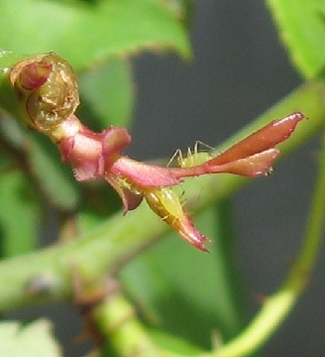
Aphids are tiny, pear-shaped pests, most commonly green or brown, but can also be red or black. They are often found in colonies (image)congregating on new leaf growth and on rose buds, sucking the plant's sap. They are perhaps the most common insect pest in regards to roses however, their damage is fairly minimal a compared with other pests. As they feed on the sap of the plant, they secrete a sticky substance that often attracts ants and can make the plant's foliage unsightly. Easy methods of aphid control include knocking them off of the plant with a strong stream of water from a garden hose, or the use of an insecticidal soap to kill them. Ladybugs are beneficial insects that help keep aphid populations under control. Most insecticides are effective against aphids. Care should be taken when spray in insecticides so that beneficial insects aren't inadvertently killed. Photos provided by S.Muragin
Leafcutter Bees

Leafcutter bees are approximately the size of common honeybees. Rarely seen, the female bee cuts neat circles from the outer margins of rose leaves for use in lining the nest. Nests are tunneled in soft, rotted wood, in pithy plants such as roses, or in similar materials. Leaf pieces are used to line the nest and form cells within it. In Hawai'i, these nests have been found hidden in the ends of fishing poles, in holes in the sides of houses, and in the old or dead wood of hedges. Most rosarians tolerate the bees and admire their handiwork, rather than destroy them. Photo by S.Muragin
Chinese Rose Beetles
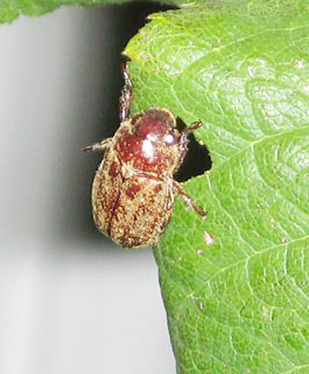
The most detrimental insect pest to affect roses in Hawai’i is, without a doubt, the Chinese Rose Beetle. Year round, these nocturnal beetles feed in groups, devouring the soft part of rose leaves (between the veins), leaving behind a lace-like pattern (image) in what remains. By day, they hide in the soil or beneath fallen leaves. One method of beetle control is the insecticide “Sevin”, in dust form, which will keep the beetles away for approximately 10 days or so. Its use,
however, may also kill beneficial insects such as bees and ladybugs. Another suggestion is the use of bright lights on your plants at dusk for a few hours (peak feeding occurs then). This may be effective at keeping the beetles away from your rose plants, as they are oddly attracted to bright light. Photos courtesy of S.Muragin.
however, may also kill beneficial insects such as bees and ladybugs. Another suggestion is the use of bright lights on your plants at dusk for a few hours (peak feeding occurs then). This may be effective at keeping the beetles away from your rose plants, as they are oddly attracted to bright light. Photos courtesy of S.Muragin.
Rose Scale
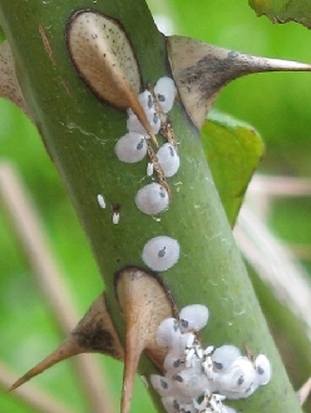
Rose scales are round, shell-covered insects that feed on the sap of rose plants. They are dirty white, gray or brown in color, are circular and rather limpet-like. In the adult form, they are immobile and are protected from insecticides by a waxy coating. They appear singly and in clusters, usually on older rose canes. Newly hatched scales are mobile and are called crawlers .It is in this stage that they can be treated with insecticides such as an insecticidal soap. The adult scales can be shot off of canes using a nozzle on a garden hose. They can also
be brushed off using an old toothbrush. If left untreated, scales can cause the discoloration and killing of canes, the wilting of leaves, and a general weakening of the host plant. Photos provided by S.Muragin
be brushed off using an old toothbrush. If left untreated, scales can cause the discoloration and killing of canes, the wilting of leaves, and a general weakening of the host plant. Photos provided by S.Muragin
Spider Mites
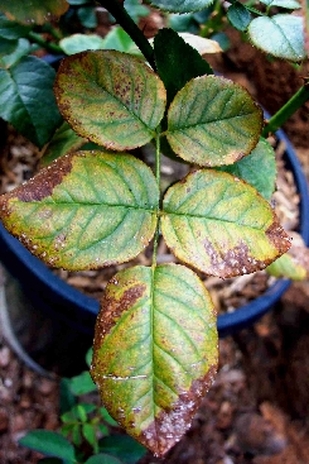
Spider mites are not insects but are tiny arachnids. Most active in the warmer months, they feed on the sap of rose leaves, leaving them speckled in appearance. In severe infestations, webbing may occur on the undersides of leaves. The leaves discolor and dry, eventually dying and dropping from the plant. Chemical methods of control for severe infestations include the use of a miticide such as Avid. Otherwise, a strong stream of water from a garden hose, done several times a week, will reduce spider mite populations and damage. Photo on left courtesy of Myrna Cariaga, below by S. Muragin.
Thrips
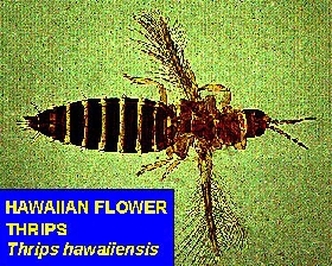
Thrips are tiny, slender black or dark brown insects (image), very active in nature. They are seldom seen because they hide inside of the buds and blooms. They have an appetite for the sap of the flower’s petals, which can cause discoloration of the petals (image) and deformation of buds as they open. Thrips tend to prefer light colored blooms although they are not partial to only these roses. In Hawai’i, thrips are almost always found in gardenia blooms. Control of this pest includes the use of insecticidal soaps or Orthene. Photo courtesy of Mark G.Wright Ph.D., Dept.of Plant & Environmental Protection Sciences, University of Hawai'i at Manoa.

